Laparoscopy is also called keyhole
surgery, a minimally invasive procedure, where surgery is performed with a
small incision of less than 3mm.
Laparoscopy uses an instrument called a
laparoscope to look into the abdominal organs.
Laparoscopy allows your doctor to see inside
your body in real-time, without open surgery. Your doctor also can obtain
biopsy samples during this procedure.
If the patient is operated through
laparoscopic technic the recovery will be faster and scar less. The patient can
be discharged early from the hospital.
Through this technic various surgery can be
performed; for example Appendectomy, Cholecystectomy, and Hernia surgery.
Laparoscopic fundoplication for GERD
GERD:
Gastro-esophageal reflux disease: This is a disease that occurs when stomach acid or bile flows into the food pipe and irritates the lining. Acid reflux and heartburn more than twice a week may indicate GERD.
Symptoms include burning pain in the chest that usually occurs after eating and worsens when lying down.
Relief from lifestyle changes and over-the-counter medication is usually temporary. Stronger medication may be required.
Surgery for GERD: GERD is initially managed with medicines. When the patient develops severe reflux, then surgery is opted for. The surgery that is done for the treatment of GERD is Laparoscopic fundoplication. This surgery gives very good results and if the patient has an associated hiatal hernia, that can also be repaired during the same.
Laparoscopic Cholecystectomy
What is Laparoscopic Cholecystectomy?
It is a surgical procedure that involves the removal of the gallbladder, a stomach organ.
What is Gallbladder?
The gallbladder is a small organ on the right side of the upper belly that stores bile, a liquid that the body needs to break down food.
What are the symptoms that are noticed if one has
Gallbladder stones or deposits?
Gallstones
can cause severe stomach discomfort, which is a very typical symptom.
Nausea, vomiting, and indigestion are other common side effects.
If the stones stop the bile duct, they may also develop jaundice and, in
certain cases, fever.
How are the problems related to
Was the gallbladder detected?
Doctors will commonly
prescribe an ultrasound or a CT scan when patients complain of abdominal pain
and the symptoms listed above.
They may also request that the patient undergo a HIDA scan in specific cases.
What are the advantages of
Laparoscopic cholecystectomy?
Smaller incisions less than
1 inch long are used to remove the gallbladder, which is preferred to open
surgery.
The recuperation time is shorter than with open surgery. The pain is minor when
compared to open surgery.
When is laparoscopic cholecystectomy
suitable for you?
A
laparoscopic cholecystectomy may be beneficial if the gallbladder problems are
severe.
And if you’ve had surgery on your upper abdomen before.
Laparoscopic Inguinal Hernia Repair
What is Inguinal Hernia and why is it caused?
When
the inner layers of the abdominal wall weaken, a hernia forms, resulting in a
bulge or rip.
As the inner tube punctures the damaged tire, the abdomen’s inner lining
presses against the weakest part of the abdominal wall, generating a
balloon-like sac. The intestine loops or the abdominal tissue rips as a result
of this.
Tissue weakening can be caused by a variety of factors, including natural
weakness, heavy lifting, chronic coughing, and straining with bowel movements
or urination.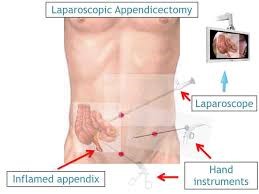
What
are the advantages of this
surgery?
The treatment uses small incisions, which take less time to heal and allow the patient to return to their normal routine fast.
What
are the treatments?
available?
There are numerous treatment methods available, and the surgeon may recommend one based on the medical history of the patient.
What
is Laparoscopic
hernia repair?
Laparoscopic Umbilical Hernia Repair
The
procedure for laparoscopically correcting a hernia is the same as for other
laparoscopic procedures. The surgeon makes incisions through which a
laparoscope (a laparoscope is a small instrument with a narrow tube that has a
light source and camera at the end of the tube) is inserted, and the surgeon
uses the Laparoscope’s video camera to locate the hernia; the hernia is then
reduced with the help of surgical equipment through the other incisions made,
and the incisions are then sealed using surgical glue or staples.
Depending on the severity of the hernia, the doctor may do an open procedure.
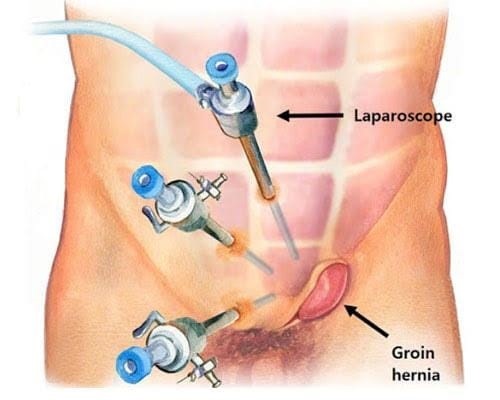
What
is an Umbilical Hernia?
An
umbilical hernia occurs when tissues from the intestine or abdominal cavity
push through a soft/weak part of the abdominal wall at the belly button. The
intestine loops or the abdominal tissue rips as a result of this.
Tissue weakening can be caused by a variety of factors, including natural
weakness, heavy lifting, chronic coughing, and straining with bowel movements
or urination. This is a condition that can affect adults as well as children.
What
are the symptoms of
Umbilical hernia?
The symptoms of Umbilical hernia are as follows :
· Swelling in Naval region
· Severe pain in the abdomen region
· The affected area might turn blue
How is the laparoscopic repair of umbilical hernia surgery
carried out?
A laparoscopic operation is
a technique that allows you to see within your body Umbilical hernia repair,
like other laparoscopic operations, is done under anesthesia.
Where the surgeon makes incisions through which a laparoscope (a laparoscope is
a small instrument with a narrow tube that has a light source and camera at the
end of the tube) is inserted, and the hernia is located using the Laparoscope’s
video camera, and the hernia is reduced with the help of surgical equipment
through the other incisions made; to strengthen the abdominal walls, the
surgeon may place a synthetic mesh and sew it in place.
The doctor may choose an open therapy depending on the severity of the hernia.
Laparoscopic Repair of Ventral Hernia
What is Laparoscopic Repair of Ventral Hernia?
A
ventral hernia is an abdominal protrusion caused by a muscular opening. The
hernia is repaired laparoscopically. When a person has had previous
Laparoscopic surgery or when muscles, particularly the abdominal muscles, are
weak, this problem can arise.
Laparoscopic ventral hernia surgery is similar to other Laparoscopic procedures
in that a Laparoscope is inserted through abdominal incisions.
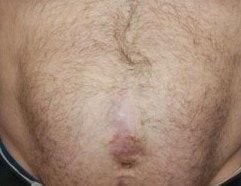
What are the symptoms of
Ventral
Hernia?
Some of the symptoms are:
· Sharp pain in the abdomen
· Visible bulge of the abdominal wall
· Nausea
· Vomiting and indigestion
How
is the surgery
performed?
To help the surgeon
discover the hernia, the physician makes three to four incisions through which
air (carbon dioxide) is pumped.
The surgeon next inserts a laparoscope (a small tool having a narrow tube, a
light source, and a camera at the end of the tube) and utilizes the video
camera on the laparoscope to locate the hernia. The hernia is subsequently
reduced using surgical instruments through the previous incisions made; the
surgeon may use a synthetic mesh and suture the area to strengthen the abdominal
walls.
Surgical glue or staples are used to close the incisions. The doctor may
propose surgery depending on the severity of the hernia.
What
are the advantages of this
surgery?
Small incisions are used in the procedure, which takes less time to heal and allows the patient to return to regular life quickly.
What are the other avenues of treatment available apart from
surgery?
There
are numerous treatment methods available, and the surgeon may recommend one
based on the medical history of the patient.
If surgery is not an option for the patient, a ‘Truss,’ which is a belt that
maintains the hernia in place as the patient goes about his daily activities,
may be recommended.
Laparoscopic Hiatal Hernia Repair
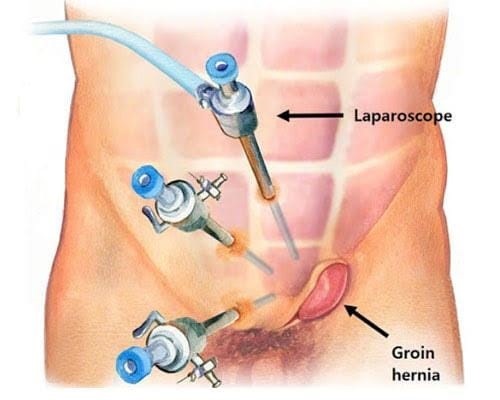 What
is Hiatal hernia?
What
is Hiatal hernia?
A hiatal hernia occurs when the contents of the abdominal cavity protrude beyond the esophageal hiatus of the diaphragm. The following variables contribute to hiatal hernia:
·
An
expanded esophageal hiatus is caused by developmental defects.
The thoracic-abdominal pressure gradient has widened.
The pharyngoesophageal membrane loses its elastic fibers as it ages.
What
are the Different Types of
Hiatal hernias?
There are four types of Hiatal hernias they are:
·
The
gastroesophageal junction is forced into the thoracic cavity, causing a sliding
hernia. This is one of the most common types of Hiatal hernias, accounting for
roughly 95 percent of all cases.
The second type is a paraesophageal hernia, in which the gastroesophageal
junction is preserved but the gastric fundus protrudes across the diaphragmatic
hiatus.
In the third sort, both the gastroesophageal junction and the stomach herniate
above the diaphragm.
The fourth type of hernia occurs when organs other than the stomach protrude
above the diaphragm, such as the colon.
What are the symptoms of
hiatal hernia?
The symptoms of hiatal hernia are :
· Difficulty in swallowing food
· Shortness of breath
· Chest and abdominal pain
· Backflow of stomach acid into the esophagus or acid reflux
· Vomiting of blood or passing of black stools, which may indicate gastrointestinal bleeding
· Feeling full as soon as you finish eating
· Heartburn
Laparoscopic Appendectomy
What is an appendix?
The appendix is a tube-like structure that connects the large intestine to the stomach and is usually found beneath the right side of the belly button.
What
is Laparoscopic appendectomy and why is it performed?
A laparoscopic appendectomy is a surgical procedure that removes the appendix in cases of appendicitis.
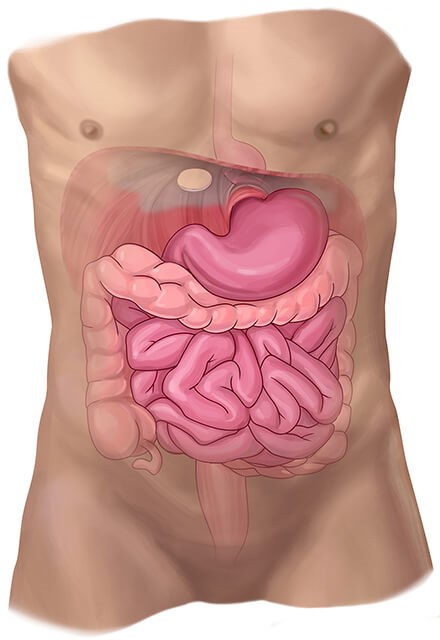 What
are the advantages of
What
are the advantages of
Laparoscopic Appendectomy?
The advantages are :
· You will spend less time in the hospital as a result of the surgery. Scarring is minimal, and the healing process is short.
What
are the symptoms of
appendicitis?
Some of the common symptoms of appendicitis are:
· Nausea and vomiting.
· Loss of appetite.
· Pain in the lower abdomen, predominantly on the right side.
· Pain in the lower abdomen while lifting something or while performing Jarring movements.
What are the avenues of
Are
treatments available?
Appendicitis can be treated with antibiotics and needle drainage operations, but these treatments have only been shown to be effective in a few cases, thus doctors usually prescribe surgery.
How
is Laparoscopic appendectomy
performed?
It’s similar to other
laparoscopic procedures in that a laparoscope is inserted through incisions
near the belly button, gas is slowly let into the abdomen, and after locating
the appendix’s correct position through the laparoscope using surgical
instruments inserted through other incisions, the appendix is gently
disconnected and removed.
In most situations, the operation requires three incisions, although it can
take up to four in some cases.
Laparoscopic GI surgery
What is gastrointestinal surgery?
Laparoscopic surgery is used to operate on the parts of the body involved in digesting. The stomach, esophagus, small and large intestines, as well as rectum, may be affected. It can be used to remove cancerous growths or damaged areas of the above-mentioned body components.
What is Laparoscopic
gastrointestinal
surgery?
·
Laparoscopic
GI surgery entails inserting a laparoscope through small incisions near the
belly button and working on the required component. This type of operation is
known as minimally invasive surgery.
The following conditions can be treated with this method:
Appendicitis is a type of appendicitis that affects the colon and other
portions of the gastrointestinal tract (Appendectomy).
The gallbladder is affected by gallbladder diseases, which are illnesses that
affect the gallbladder.
Diverticular disease is a type of granuloma that affects the intestines.
Gastroesophageal reflux disease with Hiatal hernias (GERD)
Hernia
Inflammatory bowel disease includes conditions such as Crohn’s disease and
ulcerative colitis.
Rectal prolapse is a condition in which a person’s bowels protrude through
their skin.
Bariatric surgery is also performed using this way.
What are the advantages of
gastrointestinal surgery?
The treatment uses small incisions, which take less time to heal and allow the patient to return to their normal routine fast.

